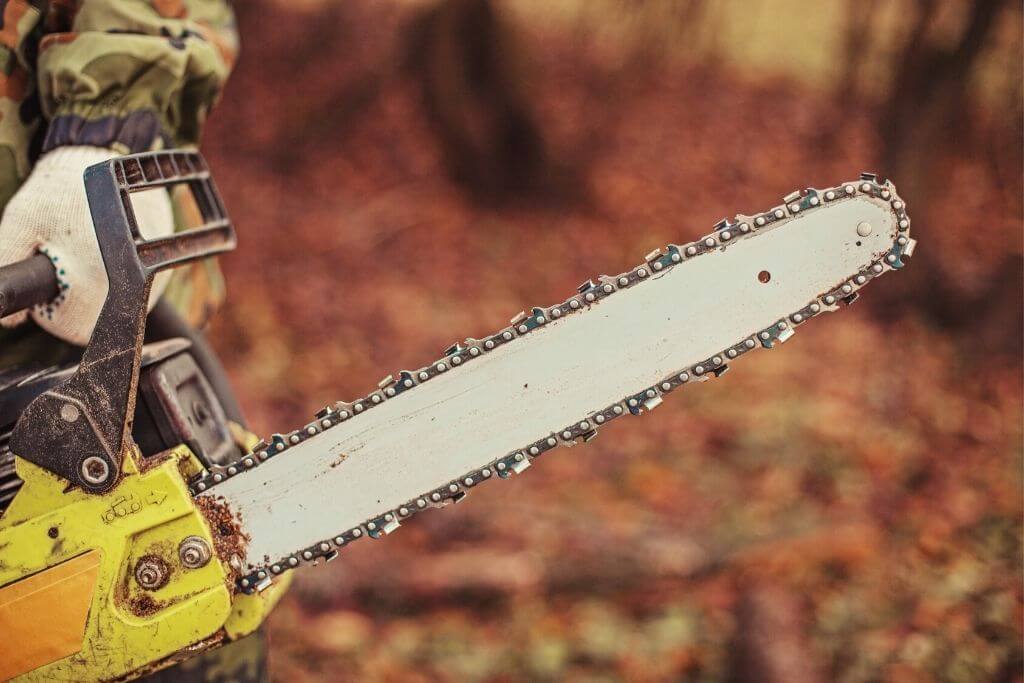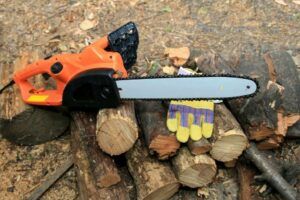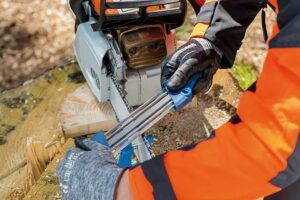
If you need to cut hardwood for your projects. Your heavy-duty chainsaw will become inefficient, time-consuming, and even dangerous, without having the best chainsaw chain for hardwood.
It is the chain that features sharp steel links held together to remove chips from hardwood until you get desired dimensions of the materials. Using the wrong chain is no good.
In this article, we will discuss the importance of picking the correct chains for your chainsaw units.
More excitingly, let’s get insight into the top 5 hardwood chains on the market under unbiased reviews.
Table of Contents
Why Do You Need A Chainsaw Chain For Cutting Hardwood?
We all agree upon the necessity of chains at the heart of the chainsaws. The chainsaw chains can remove chips quickly through the wood when they are correctly propelled around the guide bar and with the saws.

The process to cut hardwood that’s a big challenge. The chains need to move at high speeds and be aggressive so that you can cut easily through hardwood in less time.
Moreover, they help improve the accuracy and even cutting with their teeth arranged either in alternating left or right fashion and very hard.
Importantly enough, the chains minimize kickback accidents and serious injury. They prevent the depth gauge and keep the chainsaw from the kickback zone.
Using the correct chains and your chainsaw will work double efficiently. Nonetheless, if you opt-in wrong ones, it is not just inefficient but dangerous:
- The risk of rotational kickback is when chains do not fit the saw and their rotation is suddenly halted.
- You will find it hard to control the saw, which ends up inaccurate cuttings.
- The longer you handle the chains and the saw, the more fuel you waste.
5 Best Chainsaw Chains For Hardwood – Reviews
1. Oregon S56 AdvanceCut 16-Inch Chainsaw Chain
One of the best chainsaw chains on the market, this Oregon S56 AdvanceCut has always been preferred for its powerful performance through hardwood. It combines the sem-chisel design and low-vibration construction.
Accordingly, the semi-chisel teeth have rounded corners so they offer a nice bite on the wood without losing the edge.
As a result, the chain retains its sharpness for a longer time, making the Oregon S56 AdvanceCut well-worth investing.
We also appreciate that the chains are of good quality. The cutters are made out of heat-treated and hard-chromed chrome, meanwhile, all rivets are hardened to get rid of the stretching condition.
There is even the Lubri-Tec oiling system available to lubricate chains with oil so every part is running smoothly.
Almost no vibration is reported since the manufacturer creates the chain with a smaller gap to the guide bar.
The shocks generated when you cutting hardly transfer to the bar so you will not find the vibrations. You can cut more stably and accurately.
So far so good except for that the fact that semi-chisel cuts more slowly than other full-chisel versions.
- Affordable chain
- Durable moderate chisel chain
- Heavy-duty heat treated cutters
- Almost no vibrations and cut smooth
- Helpful LubriTec automatic oiling system
- Slow cutting
- Possible not compatible with some other brand chainsaws
2. Husqvarna Chainsaw Chain 18-Inch
Husqvarna Chainsaw Chain is built with an extra balance between cutting performance and cutting retention.
It comes with a pre-stretched construction out of the box. You do not need to adjust the tension of the bar.
That way, the chain will be better adjusted to fit your saw and you can focus on cutting projects rather than changing the tension several times.
You should also know that the Husqvarna Chainsaw Chain is bigger than the Oregon S56 AdvanceCut: 18 inches vs 16 inches.
The built-in gauge is 0.050 inches and the pitch measurement is 3/8 inches. Such dimensions allow the chain to cut through very hardwood or firewood.
The vibration is very little so you still rest assured about the cutting accuracy and the longevity of the chain.
Based on the bespoke information in the manual guide, the Husqvarna chain can work with several Ranchers versions including 55, 257, 262 XP, 455, 460, etc.
There are some users who reported about the compatibility of the chain with other brands.
The noticeable downside is the price. Users complain that they can buy a bunch of other chains with similar features. However, the Husqvarna Chainsaw Chain is expensive but well worth it.
- Big chain for big and hardwood
- Suited for commercial users as well as homeowners
- Low-vibration performance
- Low-kickback tag
- Expensive compare other models
- Some compatible problems
3. Stihl Chainsaw Chain – 26RS68
If you only do some small DIY projects with hardwood, you do not need to break a bank for the expensive Husqvarna Chainsaw Chain. Stihl Chainsaw Chain 26RS68 18 Inch is an alternative.
The manufacturer uses the RAPID Micro chain which has a taller-profile chain to work versatility with different displacement engines from small and large saws.
However, we often recommend using this chain for small models since the chain has a yellow label, meaning that the chain has a reduced kickback rather than completely no-kickback. If you use two powerful saws, it is harder to control the chain.
To make up for the power cutting, the Stihl 26RS68 is 0.063 inches, thicker than other chains so it has longer retention of sharp edges. It does not get dull quickly.
There is a big lack is that some chain sets do not have the kickback warming labels. You had better confirm with the seller in advance to have the right chains that you want.
- Lightweight and durable cutter
- Low kickback and low-vibration
- Faster cutting
- Suitable with machines that small to large engines
- Lack of warning label
- Not self lubricating
4. SUNGATOR 3-Pack 18 Inch Chainsaw Chain
The Sungator is not a chain that will make you surprised about its cutting performance or durability. However, you will agree that the chain is a great deal for the money.
You will have a chain of 62 drive links equivalent to 18 inches large, along with ⅜-inch pitch measurements, and 0.050-inch gauge measurement.
It has similar dimensions to the Stihl. We meant the low vibration and low-kickback construction, so you can use this chain on small chainsaws.
The manufacturer confirms that the chain can work with models from Homelite, Greenworks, Husqvarna, Remington, Echo, Poulan, Ryobi, etc.
You can install and uninstall all parts for maintenance in a breeze. This is a real plus when you do not have much experience working with chainsaw chains before.
The chain cuts pretty well through the hardwood thanks to the hard-chrome plated cutters. The round-cornered semi-chisel also increases its wear resistance.
However, some parts of the SUNGATOR 3-Pack 18 Inch Chainsaw Chain, such as the rivets, are not as durable as the other options on the list.
- Extremely low price
- Little wear on the cutter
- Low vibration and no kickback
- Fit various chainsaws model
- Not durable rivets
- Frequent lubrication needed
5. Poulan/weed eater 051338 Poulan Pro
Like most of the chainsaw chains for hardwood, the 051338 Poulan Pro model is also made of heat-treated material.
However, the big plus is that the company uses quality steel for its chains. You can use the chain for over a year and after several sharpening. The chain will not be dull easily.
The cutting performance is not the best on this list. Nonetheless, we appreciate that the chain runs smoothly thanks to its vibration-dampening addition. As long as you keep the teeth sharp, you will not experience major issues.
You should keep in mind that the Poulan Pro only features a low-kickback yellow label rather than the no-kickback green one. Thus, you had better using the chain on a suitable chainsaw to guarantee your safety.
We have to say that this unit has more compatibility problems than others. You should check carefully whether your chainsaw supports the chain of Poulan Pro.
- Frequent sharpening allows
- Smooth and vibration-free cutting
- Great durable
- Easy install and maintenance
- Limited compatibility with other models
- Quite expensive
How To Choose The Best Chainsaw Chain For Hardwood

Length
Always start choosing the chainsaw chains by considering their bar length. It is counted by the number of drive links available.
If the length is too big, the chain will not tightly fit the saw bar, meanwhile, a short-chain can cause snug cutting or it even will not go on the bar at all.
For hardwood chainsaws, the chain often should be from 10 to 24 inches.
Pitch
Pitch indicates how close the drive links are together on the chain by calculating the half distance between any three rivets.
It varies in sizes such as 0.404 inches, 3/8 inches, 3/8 low-profile, 0.325 inches, and 1.4 inches.
You can find the measurement on the guide bar or in the user guide of the chain. If you fail to find it, you can calculate the pitch by measuring the distance between three rivets and dividing the number by two.
Whichever size you choose, you must ensure that the pitch should match the distance between the teeth on drive sprockets and the bar tip sprockets.
When it comes to cutting hardwood, the common pitch values are either 3/8 inches, 3/8 inches low-profile, or 0.404 inches.
A larger pitch means a bigger chain and more aggressive cuttings you will have since it displaces more wood with each round.
Drive Links And Gauge Measurements
Drive links are the bottom part of the chains which securely fit into the guide bar. You must know the number of links so that you can get the overall length of chains you need to use, in combination with the pitch measurements.
It is also essential to figure out the thickness of drive links, as known as gauge measurements in inches.
Too thin gauge causes the chain to slip out of the bar during operation. Not to mention, thin links are not durable enough to handle high-speed cuttings. Whereas, the too thick gauge will be useless if it does not fit the bar.
Typical gauges are 0.043 inches, 0.05 inches, 0.058 inches, and 0.063 inches. You see that differences in measurements are very small. An incompatible chain can still be installed in the saw, leading to ineffective performance.
Thus, you must always check the required gauge measurements carefully on the chainsaw’s specifications or on the user-end of the guide bar. For hardwood cutting, 0.05 inches is the most common.

Tooth Style – Full Chisel vs Semi Chisel Chains
Chisel refers to the way teeth are cast on the chain. It ends up determines how well the chain can cut through the materials.
Although there are three tool styles available which are chirper, semi-chisel, and full-chisel. Hardwood chainsaws are often compatible with the two latter.
- Full chisel chains
Full chisel often has square-cornered cutting teeth thanks to which they can cut through hardwood such as oak or walnut quickly and efficiently.
The disadvantage, however, is the fact that the square-shaped full chisel often wears out more easily, leaning to a significantly increased kickback possibility.
We only recommend this tooth style for professionals who have experience in using chainsaws and cutting hardwood.
- Semi chisel chains
Semi chisel teeth are often round-cornered. They are more versatile and durable. You can cut both soft and hardwood without being worried about the worn edges in a short time.
Obviously, the semi-chisel chains cut more slowly and they might not be able to deal with frozen or extra-dirty hardwood.
Chain Arrangement
Do not mistake the chain arrangement for the tooth styles. It is the configuration of cutters and drive links on the chain. There are three types available.
- Full complement chain
This is the typical chain agreement in which there is a right-sided cutter, followed by a link and an additional left-sided cutter. The full-complement chain often reduces the kickback risks.
- Skip chain
When drive links are separated by two cutters, we have a skip chain. It is good for hardwood projects since the chain cuts faster and more aggressively with few cutter teeth.
- Semi skip chain
In between is the semi-skip chain. The right-sided cutter, a drive link, and the left-sided cutter are available, yet followed by two links. The chain offers a balance of aggressiveness and kickback safety.
Compatibility
This is an overall feature. You must ensure that the chains are compatible with your chainsaws. It is not only about the bar length, pitch measurements, and gauge measurements, but it is also related to the type of chainsaws.
We would recommend checking the manufacturers’ website where you can find a list of all saw types that are compatible with specific chains.

Anti Kickback
Kickback is the most typical – and also the most disastrous, chainsaw-related accident.
It often happens when the chains suddenly stop and the saw gets pinched and launches back toward the user.
Most chainsaw chains today come with a tag to indicate how prone they are to cause a kickback.
A green tag means low-kickback, meanwhile, the yellow-tagged chains are more likely to kickback. The yellow is reserved for experienced woodworkers only.
Anti-Vibration
Vibration is another annoyance faced by users when they use the chain.
First and foremost, it affects the cutting accuracy. Secondly, the vibrating noise ruins your concentration. Lastly, significant power will be lost due to the vibration.
It is best if you choose chains that are free of vibration.
Lubrication
Another practice to prevent the kickback is to lubricate the chain frequently. It reduces the heat and friction generated when the chains spin constantly.
Many modern chainsaws have built-in lubrication to drip oil onto the chains. You can also manually remove parts of chains to add lubrication. Therefore, you should use units that are easily and safely unpacked.
Frequently Asked Questions About Chainsaw Chain (FAQs)

How To Prevent Kickback With Chainsaw Chains?
You must ensure that the chains are compatible with your cutting saws in terms of length and depth.
Moreover, installing and operating the chain properly are also required to prevent accidents. Lastly, keep an eye on the chains and their parts to do the necessary maintenance and replacement.
When Should I Replace My Current Chainsaw Chain?
It depends on the current conditions of the chains and your cutting demands.
For instance, if you switch from pine softwood into seasoned oak hardwood, you had better replace your chain with one of the best chainsaw chains we introduced above.
Otherwise, it is time for a replacement after you have already resharpened the chains several times and found some service marks or chipped height of teeth.
Another obvious reason to replace the chains is their missing teeth – 10% or 15% of the full number. Without enough teeth, the chains cut ineffectively and generate many vibrations.
You also should not use cracked or loosen drive links because they can break anytime during cuttings and cause dangerous kickback injuries.
How To Change Your Chainsaw Chain?
If you are careful and skilled enough, you can replace the chains on your own with a set of socket wrenches and screwdrivers, following three steps:
- Remove the side plate and release the bar’s tension adjuster. Then, you are able to remove the current chain from the guide bar.
- Install the new unit, having its edge faced down. Place the bar and tighten it in place with the available side plate. You must also adjust the tension so that the chain is snapped back securely.
- Tighten the bolts to fix the side plate in the right position
What Is The Ideal Tightness of Chainsaw Chains For Hardwood?
The chains will naturally stretch and loosen on the bar over time. Therefore, you need to ensure that it is tightened correctly in the first place and before cutting.
Checking the tension on a regular basis is the best practice. An easy testing way is to lift the chain off the bar. You should not be able to pull the links out.
Otherwise, you must increase the tension. It is also not recommended to over-tighten the chain or it can break during operation.
Most manufacturers suggest ideal tightness on their manual. You need to check that bespoke information in advance.
Do I Need To Sharpen Often My Chainsaw Chain For Hardwood?
Yes, you should sharpen the chain to its optimal gauge settings. The frequency of sharpening will depend on the damage conditions and the materials of the chain.
How To Sharpen The Chains?
There are two ways to sharpen your chain, using either a file or a grinder.
- Using a file guide
There are tools having several files built in to sharpen the cutter and bar to different angles. You can simply give the chain two or several swipes through the files.
- Using a grinder
The grinder can smoothly sharpen the chains in no time. However, the tool takes off more metal and you will end up replacing the chains more regularly.
Final Thoughts
We hope that you already found a suitable chain for your hardwood cutting projects.
In case you are still in mind, we would suggest the Oregon S56 AdvanceCut as the best overall.
This chain gives off a balance of cutting performance and quality build so that you can cut faster and longer with no vibration as well as safer with low kickback. More excitingly, the price is still affordable.
Another option is the poulan/weed eater 051338 Poulan Pro. Despite the quite high price tag, the chain will not let you down about its durability and the sharp cut over time!










![9 Best Pole Saws of 2023 [Ultimate Guide] 9 Best Pole Saws of 2023 [Ultimate Guide]](https://handykeen.b-cdn.net/wp-content/uploads/2021/03/best-pole-saw-300x200.jpg)
